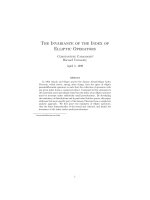Tài liệu The Synchronisation of Telecommunications Network doc
Bạn đang xem bản rút gọn của tài liệu. Xem và tải ngay bản đầy đủ của tài liệu tại đây (466.96 KB, 185 trang )
Issue 05/01 Slide 1.1
Oscilloquartz SA
The Synchronisation of
Telecommunications Networks
Issue 05/01 Slide 1.2
Oscilloquartz SA
Contents
Contents
I. The Need for Synchronisation
II. Characterizing Synchronisation Quality
III. Synchronisation Distribution: General Principles
IV. Synchronisation Distribution: SDH/SONET-based
Solution
1. Elements
2. Architecture
3. Synchronisation Status Message (SSM)
V. Synchronisation Distribution: GPS-based and
MixedSolution
I. The Need for Synchronisation
II. Characterizing Synchronisation Quality
III. Synchronisation Distribution: General Principles
IV. Synchronisation Distribution: SDH/SONET-based
Solution
1. Elements
2. Architecture
3. Synchronisation Status Message (SSM)
V. Synchronisation Distribution: GPS-based and
MixedSolution
Issue 05/01 Slide 1.3
Oscilloquartz SA
Contents
Contents
VI. Synchronisation Distribution: From Co-operating
Network
VII. Summary on Standards
VIII. How to Synchronize Mixed Technology
Networks
1. Mixed Technology Network Example
2. SDH and SONET Networks
3. The Public Switched Telephony Network
VI. Synchronisation Distribution: From Co-operating
Network
VII. Summary on Standards
VIII. How to Synchronize Mixed Technology
Networks
1. Mixed Technology Network Example
2. SDH and SONET Networks
3. The Public Switched Telephony Network
Issue 05/01 Slide 1.4
Oscilloquartz SA
Contents
Contents
VIII. How to Synchronize Mixed Technology
Networks (cont ’d)
4. ATM Networks
5. Optical Networks
6. GSM and UMTS-FDD Radio Access Networks
7. cdmaOne and cdma2000 Radio Access Networks
VIII. How to Synchronize Mixed Technology
Networks (cont ’d)
4. ATM Networks
5. Optical Networks
6. GSM and UMTS-FDD Radio Access Networks
7. cdmaOne and cdma2000 Radio Access Networks
Issue 05/01 Slide 1.5
Oscilloquartz SA
Abbreviations
Abbreviations
» ADM Add Drop Multiplexer
» ATM Asynchronous Transfer
Mode
» BITS Building Integrated Timing
Supply
» bit/s bits per second
1kbit/s = 1,000 bits/s
1Mbit/s = 1,000,000 bits/s
1Gbit/s = 1,000,000,000 bit/s
» CBR Constant Bit Rate
» CDV Cell Delay Variation
» DNU Do Not Use
» DXC Digital Cross-Connect
» f frequency
» FIFO First-In First-Out
» GPS Global Positioning System
» GUI Graphical User Interface
» HSC High Stability Clock
» ADM Add Drop Multiplexer
» ATM Asynchronous Transfer
Mode
» BITS Building Integrated Timing
Supply
» bit/s bits per second
1kbit/s = 1,000 bits/s
1Mbit/s = 1,000,000 bits/s
1Gbit/s = 1,000,000,000 bit/s
» CBR Constant Bit Rate
» CDV Cell Delay Variation
» DNU Do Not Use
» DXC Digital Cross-Connect
» f frequency
» FIFO First-In First-Out
» GPS Global Positioning System
» GUI Graphical User Interface
» HSC High Stability Clock
» Hz Hertz (cycles per second)
1mHz = 0.001Hz
1 µHz = 0.000001Hz
» ITU International Telecommunications
Union
» k kilo = 1,000
» LOS Loss Of Signal
» LT Line Terminal
» MTIE Maximum Time Interval Error
» NE Network Element
» OC-N Optical Carrier level N
» OS Operating System
» p pointer
» PABX Private Automatic Branch
Exchange
» PDH Plesiochronous Digital Hierarchy
» PEC Plesiochronous Equipment Clock
» PLL Phase Locked Loop
» Hz Hertz (cycles per second)
1mHz = 0.001Hz
1 µHz = 0.000001Hz
» ITU International Telecommunications
Union
» k kilo = 1,000
» LOS Loss Of Signal
» LT Line Terminal
» MTIE Maximum Time Interval Error
» NE Network Element
» OC-N Optical Carrier level N
» OS Operating System
» p pointer
» PABX Private Automatic Branch
Exchange
» PDH Plesiochronous Digital Hierarchy
» PEC Plesiochronous Equipment Clock
» PLL Phase Locked Loop
Issue 05/01 Slide 1.6
Oscilloquartz SA
Abbreviations
Abbreviations
» PRC Primary Reference Clock
» ps/km/°C pico seconds per kilometre
per degree centigrade
» QL Quality Level
» QOS Quality Of Service
» s second
1ms = 0.001s
» SASE Stand Alone Synchronous
Equipment
» SD Synchronisation Distribution
» SDH Synchronous Digital Hierarchy
» SC SONET Clock
» SEC Synchronous Equipment Clock
» SETG Synchronous Equipment Timing
Generator
» SETS Synchronous Equipment Timing
Source
» sin Sine function
» SOH Section OverHead
» SONET Synchronous Optical Network
» SRTS Synchronous Residual Time
Stamp
» PRC Primary Reference Clock
» ps/km/°C pico seconds per kilometre
per degree centigrade
» QL Quality Level
» QOS Quality Of Service
» s second
1ms = 0.001s
» SASE Stand Alone Synchronous
Equipment
» SD Synchronisation Distribution
» SDH Synchronous Digital Hierarchy
» SC SONET Clock
» SEC Synchronous Equipment Clock
» SETG Synchronous Equipment Timing
Generator
» SETS Synchronous Equipment Timing
Source
» sin Sine function
» SOH Section OverHead
» SONET Synchronous Optical Network
» SRTS Synchronous Residual Time
Stamp
» SSM Synchronisation Status Message
» SSU Synchronisation Supply Unit
» STM-N Synchronous Transport Module
level N
» STS-N Synchronous Transport Signal
level N
» TF Transfer Function
» TIE Time Interval Error
» TS0 Time Slot Zero
» VBR Variable Bit Rate
» VCO Voltage Controlled Oscillator
» VC Virtual Container
» VT Virtual Tributary
» VTG Virtual Tributary Group
» UN Undefined
» W Wander
» w radians per second
» d variation
» SSM Synchronisation Status Message
» SSU Synchronisation Supply Unit
» STM-N Synchronous Transport Module
level N
» STS-N Synchronous Transport Signal
level N
» TF Transfer Function
» TIE Time Interval Error
» TS0 Time Slot Zero
» VBR Variable Bit Rate
» VCO Voltage Controlled Oscillator
» VC Virtual Container
» VT Virtual Tributary
» VTG Virtual Tributary Group
» UN Undefined
» W Wander
» w radians per second
» d variation
Issue 05/01 Slide 1.7
Oscilloquartz SA
The Need for Synchronisation
The Need for Synchronisation
Issue 05/01 Slide 1.8
Oscilloquartz SA
Frequency synchronisation
Frequency synchronisation
System A
t
t
Clock signal of system A
Clock signal of system B
System B
T
A
= 1 / f
A
T
B
= 1 / f
B
f
A
= f
B
Issue 05/01 Slide 1.9
Oscilloquartz SA
Phase synchronisation
Phase synchronisation
System A
t
t
Clock signal of system A
Clock signal of system B
System B
!
!!
Issue 05/01 Slide 1.10
Oscilloquartz SA
Time synchronisation
Time synchronisation
System A
t
t
Time signal of system A
Time signal of system B
System B
14/01/00
08:34:56
14/01/00
08:34:57
14/01/00
08:34:55
14/01/00
08:34:55
14/01/00
08:34:56
14/01/00
08:34:57
Issue 05/01 Slide 1.11
Oscilloquartz SA
Where do we need synchronisation?
Three examples
Where do we need synchronisation?
Three examples
» Public Switched Telephone Networks
» SONET and SDH transport networks
» Cellular mobile telecom networks
» Public Switched Telephone Networks
» SONET and SDH transport networks
» Cellular mobile telecom networks
Issue 05/01 Slide 1.12
Oscilloquartz SA
Public Switched Telephone Network:
Synchronous Multiplexing
Public Switched Telephone Network:
Synchronous Multiplexing
30 x 64 kbit/s 1 x 2.048 Mbit/s
Multiplexer
30
1
2
1 2
30
Issue 05/01 Slide 1.13
Oscilloquartz SA
Public Switched Telephone Network:
Space-Time Switching
Public Switched Telephone Network:
Space-Time Switching
Switch
1 2 3 54 6
1 2 3 54 6
N x 2.048 Mbit/s N x 2.048 Mbit/s
Issue 05/01 Slide 1.14
Oscilloquartz SA
What is a slip?
What is a slip?
» A slip occurs when a buffer over- or
underflows due to differences in timing
» A slip occurs when a buffer over- or
underflows due to differences in timing
Incoming data rate
Outgoing data rate
Slip
Slip
Incoming data rate
Issue 05/01 Slide 1.15
Oscilloquartz SA
Some services affected by slips
Some services affected by slips
» Voice
» Uncompressed - only 5% of slips lead to clicks
» Compressed - a slip will cause an audible click
» Facsimile
» A slip can wipe out several lines
» Modem
» A slip can cause several seconds of drop out
» Compressed video
» A slip can wipe out several lines
» More slips can freeze frames for several
seconds
» Encrypted/compressed data protocol
» Slips will reduce transmission throughput
» Voice
» Uncompressed - only 5% of slips lead to clicks
» Compressed - a slip will cause an audible click
» Facsimile
» A slip can wipe out several lines
» Modem
» A slip can cause several seconds of drop out
» Compressed video
» A slip can wipe out several lines
» More slips can freeze frames for several
seconds
» Encrypted/compressed data protocol
» Slips will reduce transmission throughput
Issue 05/01 Slide 1.16
Oscilloquartz SA
Slip rate due to frequency deviation
Slip rate due to frequency deviation
» Slip rate = fractional freq. dev / frame
duration
» For 2 Mbit/s signals, frame duration =
125 microseconds :
»10
-11
= 1 slip in 4.8 months
»10
-10
= 1 slip in 14.5 days
»10
-9
= 1 slip in 1.45 days
»10
-8
= 6.9 slips per day
»10
-7
= 2.9 slips per hour
»10
-6
= 28.8 slips per hour
»10
-5
= 4.8 slips per minute
» Slip rate = fractional freq. dev / frame
duration
» For 2 Mbit/s signals, frame duration =
125 microseconds :
»10
-11
= 1 slip in 4.8 months
»10
-10
= 1 slip in 14.5 days
»10
-9
= 1 slip in 1.45 days
»10
-8
= 6.9 slips per day
»10
-7
= 2.9 slips per hour
»10
-6
= 28.8 slips per hour
»10
-5
= 4.8 slips per minute
Issue 05/01 Slide 1.17
Oscilloquartz SA
A customer affected by slips:
A customer affected by slips:
Issue 05/01 Slide 1.18
Oscilloquartz SA
SDH/SONET Transport Networks:
Nominally Synchronous Multiplexing
SDH/SONET Transport Networks:
Nominally Synchronous Multiplexing
63 x E1 1 x STM-1
Multiplexer
63
1
2
OH 1 2 63
Issue 05/01 Slide 1.19
Oscilloquartz SA
Wander induced by pointer activity
Wander induced by pointer activity
t
TIE of E1 signal
t
TIE of E1 signal
PRC
NE
NE
NE
SDH/SONET Network
ADM
E1
ADM
E1
Synchronisation distribution
trails affected by wander
Issue 05/01 Slide 1.20
Oscilloquartz SA
SDH/SONET Transport Networks:
Nominally Synchronous Multiplexing
SDH/SONET Transport Networks:
Nominally Synchronous Multiplexing
» PDH tributaries need not be synchronous
with the SDH aggregates (pointer
technique).
» However, relative wander between the
incoming PDH tributary and the SDH
aggregates induce wander on the outgoing
PDH tributary (pointer adjustments!).
» If excessive, this tributary wander causes
slips.
» PDH tributaries need not be synchronous
with the SDH aggregates (pointer
technique).
» However, relative wander between the
incoming PDH tributary and the SDH
aggregates induce wander on the outgoing
PDH tributary (pointer adjustments!).
» If excessive, this tributary wander causes
slips.
Issue 05/01 Slide 1.21
Oscilloquartz SA
Cellular Mobile Telecom Networks
Cellular Mobile Telecom Networks
BTS
BTS
BTS
BTS
Successful handover requires synchronisation between
base transceiver stations (BTS)
Issue 05/01 Slide 1.22
Oscilloquartz SA
Cellular Mobile Telecom Networks
Cellular Mobile Telecom Networks
Radio carrier frequencies must be synchronized precisely
in order to prevent cross-talk
Radio spectrum
Frequency
Issue 05/01 Slide 1.23
Oscilloquartz SA
Characterizing
Synchronisation Quality
Characterizing
Synchronisation Quality
Issue 05/01 Slide 1.24
Oscilloquartz SA
Definition of jitter : ITU-T Rec. G.810
Definition of jitter : ITU-T Rec. G.810
 The short term variations of the significant
instants of a digital signal from their
reference positions in time
 Greater than 10Hz in modulation frequency
 The short term variations of the significant
instants of a digital signal from their
reference positions in time
 Greater than 10Hz in modulation frequency
Ideal
Ideal
Jittered
Jittered
Sampling (reading) points
Sampling (reading) points
Issue 05/01 Slide 1.25
Oscilloquartz SA
Definition of jitter : ITU-T Rec. G.810
Definition of jitter : ITU-T Rec. G.810
 The short term variations of the significant
instants of a digital signal from their
reference positions in time
 Greater than 10Hz in modulation frequency
 The short term variations of the significant
instants of a digital signal from their
reference positions in time
 Greater than 10Hz in modulation frequency
Ideal
Ideal
Jittered
Jittered
Sampling (reading) points
Sampling (reading) points









